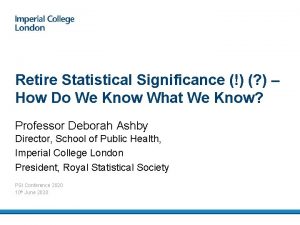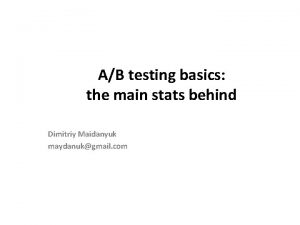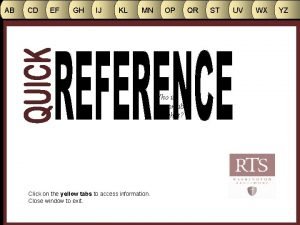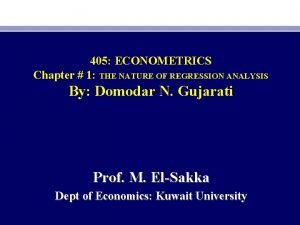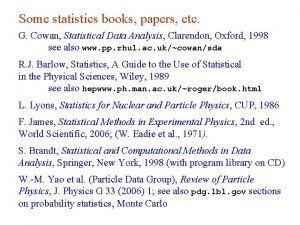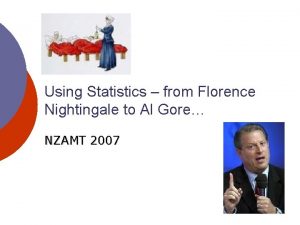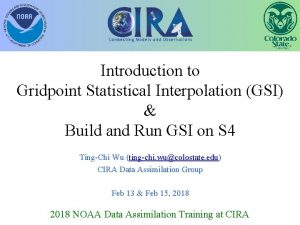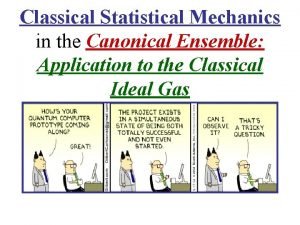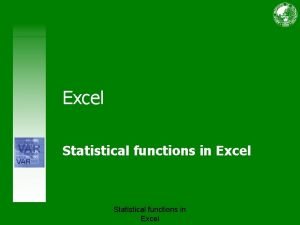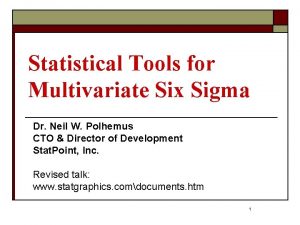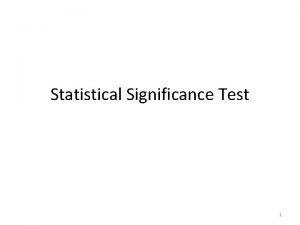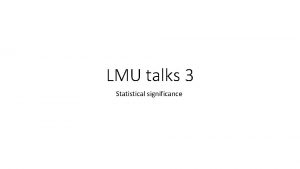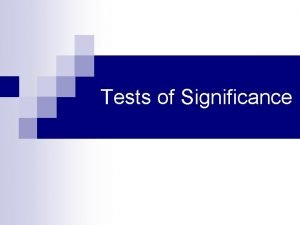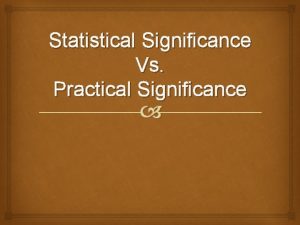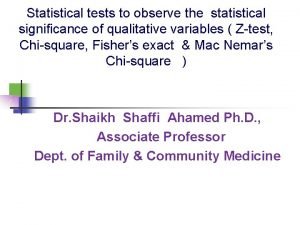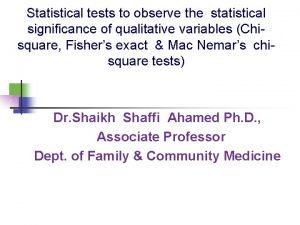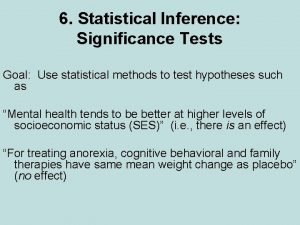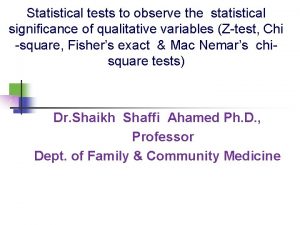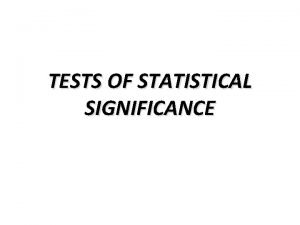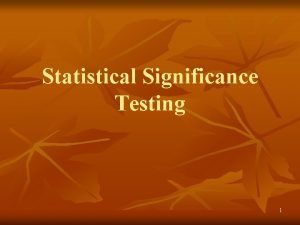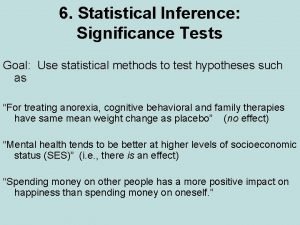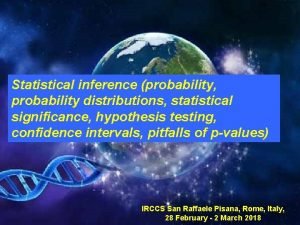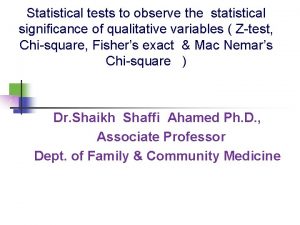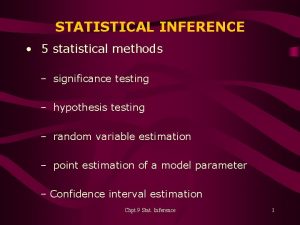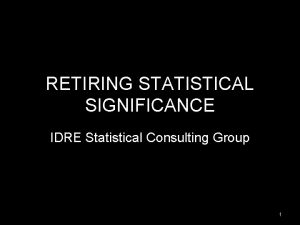Retire Statistical Significance How Do We Know What





















- Slides: 21

Retire Statistical Significance (!) (? ) – How Do We Know What We Know? Professor Deborah Ashby Director, School of Public Health, Imperial College London President, Royal Statistical Society PSI Conference 2020 10 th June 2020

What do the following have in common? • Fire • Money • Knives • Power • Statistical significance

Inappropriate use of significance testing: bioequivalence • Not significantly different does NOT imply equivalence • Need to specify equivalence margins for parameter of interest eg 90% CI for ratio of AUCs within (80%, 125%) (Drug regulation mid-1990’s) • “To be inside the acceptance interval the lower bound should be ≥ 80. 00% when rounded to two decimal places and the upper bound should be ≤ 125. 00% when rounded to two decimal places. ” – (CHMP Guideline on the Investigation of Bioequivalence 2010)

Inappropriate use of significance testing: baseline testing From the ‘editors concerns’ from NEJM clinical trial submission 2016: 6) The editors generally request that tables of baseline characteristics include information about the baseline variables, since strictly speaking all baseline differences have presumably occurred at random. However, we consider it useful to calculate the (nominal) P values for these comparisons, and to indicate with an asterisk and footnote which (if any) of the baseline characteristics differ at P <0. 05. Please provide this information for new Table 1 and 2. So, on the basis of choosing our fights carefully, we ended up with a similar statement to the other statistician’s as footnotes to the first two tables. We declined to use the recommended asterisk, we did give the actual P-value. Table 1 had no sig diffs, Table 2 had one at P=0. 02. Quelle surprise! (Correspondence with Doug Altman, who was facing similar battles with NEJM)

Appropriate use of significance testing: baseline testing • Fraud detection in clinical trials

Quantifying heterogeneity in a meta-analysis • I 2 much more informative than Q (Julian Higgins and Simon Thompson Si. M, 2002)

Meta-Analysis: Forest plot of the effectiveness of dexamethasone in preventing the recurrence of acute severe migraine headache in adults compared with placebo. Sedgwick P BMJ 2011; 341: bmj. d 229 © 2011 by British Medical Journal Publishing Group

Meta-Analysis: Forest plot Comparison of fixed and random effects meta-analytical estimates of the effect of intravenous magnesium on mortality after myocardial infarction. Sterne J A C et al. BMJ 2011; 343: bmj. d 4002 © 2011 by British Medical Journal Publishing Group

Why is statistical significance so abused? • Stems from a desire to make decisions • Seems nicely binary with language of “reject” and “accept” • cf dichotomisation • We can always do better by focussing on estimation with its associated uncertainty

Should we retire statistical significance? Nature Comment 20 March 2019 Scientists rise up against statistical significance Valentic Armhein, Sander Greenland, Blakce Mc. Shance and more than 800 signatories call of an end to hyped claims and the dismissal of possibly crucial effects.

RSS comments • Deborah Ashby, RSS President “I understand the desire for a ‘simple’ rule of thumb – but a naïve interpretation of p-values can lead to seriously wrong conclusions such as whether medicines are effective of not. This is well understood by many but misused by many more. I’ve signed to help draw attention to the dangers of this outdated practice and promote the wider use of better alternatives. ” • David Spiegelhalter, RSS Past-President “I like p-values, but feel they are delicate things and should not be crudely split into “significant” and “not-significant”. I signed this article because I am fed up with researchers claiming a discovery when p<0. 05, and claiming there is no effect when p>0. 05. ”

RSS comments continued • Guy Nason, RSS Vice-President for academic affairs “I signed the article because I agree with it! I am often surprised by how the outcomes of statistical methods are used to communicate results with unwarranted definiteness, based on assumptions, sometimes hidden, for which there is also usually considerable uncertainty. I particularly liked the article’s idea to talk about results’ compatibility with the data. ” • Stephen Senn, former RSS Council Member “Information is rarely dichotomous but decisions often are. Significance versus non-significance as a qualitative absolute distinction is ridiculous. As a threshold for action it may sometimes be justified but the appropriate standard will differ according to context. ”

Decision making • • • Proper approaches to decision making exist if we need to formalise it Decision-making under uncertainty closely allied with Bayesian statistics for decades, especially in health applications e. g. Raiffa, Schlaiffer, Cornfield, Lindley, Smith AFM, Smith J, Spiegelhalter, Berry, Parmigiani – see Ashby, Si. M, 2006 for key references Extend uncertainty analysis in a probabilistic model Landscape for decisions through entire distributions Growing applications but there is still resistance

The licensing challenge • The task of regulators (e. g. EMA, FDA) is to make a good and defensible decisions on which medicines should receive a license for which indications, based on the available evidence of risks and benefits • It is increasingly important to be able to justify and explain these decisions to patients and other stakeholders. • Can more formal approaches of decision-making, and especially more modern methods of graphical display help regulators do these better?

Methodologies available Benefit-risk assessment framework Metric indices for B-R assessment Descriptive framework Quantitative framework Threshold indices Health indices Trade-off indices PROACT-URL ASF BRAT FDA BRF CMR-CASS COBRA SABRE UMBRA OMERACT 3 x 3 BLRA NCB Decision tree MDP MCDA SMAA SBRAM CUI DI NNT NNH AE-NNT RV-NNH Impact numbers MCE RV-MCE MAR NEAR QALY DALY HALE Q-TWi. ST UT-NNT INHB BRR GBR Principle of 3 TURBO Beckmann Estimation techniques Utility survey techniques DAGs PSM CPM ITC MTC CDS SPM CV CA DCE Non –quantitative Mt-Isa et al. Balancing benefit and risk of medicines: a systematic review and classification of available methodologies. Pharmacoepidemiology and Drug Safety 2014. DOI: 10. 1002/pds. 3636. -----o----AHP Swing-weighting MACBETH

Value tree: Natalizumab case study Reduction in relapse rate Benefits Slowdown in disability progression Administration PML Reactivation of serious herpes viral infections Benefit-risk balance Serious side effects Seizures Abortion or congenital abnormalities Risks Transaminase elevation Infusion or injection site reactions Mild side effects Hypersensitivity reactions Flu-like reactions 16

Natalizumab: MCDA weighted utilities analysis Contribution of each outcome for Natalizumab vs. placebo • The Benefit-risk is the product of the weight and the value. • Most of the Benefitrisk contribution is coming from prevention of relapses. • Infusion site reactions are the worst risk 17

Natalizumab: Bayesian sensitivity analysis Distribution of overall benefit-risk score P(natalizumab ranked 1 st) = 1 18

Dissemination and recommendations arising from PROTECT http: //PROTECTBenefit. Risk. eu/ 19

Alternatives to statistical significance • Estimate quantities of interest • Show uncertainty from statistical modelling • Acknowledge other sources of uncertainty e. g. uncertainty about model, biases • Consider more formal approaches to decision making

Significance from the RSS and ASA not to be retired!
 Retire statistical significance
Retire statistical significance Statistical significance p value
Statistical significance p value Evanmiller.org ab testing
Evanmiller.org ab testing Pr retire americanfunds
Pr retire americanfunds Pre-hire to retire
Pre-hire to retire Navegue fernando pessoa
Navegue fernando pessoa Hepaclem bienfaits
Hepaclem bienfaits Retire.hartfordlife.com
Retire.hartfordlife.com Retire online pearson
Retire online pearson No texto a seguir há um trecho que se tomado literalmente
No texto a seguir há um trecho que se tomado literalmente Strip or retire
Strip or retire Know history know self
Know history know self Do deep generative models know what they don’t know?
Do deep generative models know what they don’t know? I'm holding on to your promises you are faithful
I'm holding on to your promises you are faithful Econometrics chapter 1
Econometrics chapter 1 Cowan statistical data analysis pdf
Cowan statistical data analysis pdf Florence nightingale statistical graphics
Florence nightingale statistical graphics Gridpoint statistical interpolation
Gridpoint statistical interpolation Partition function in statistical mechanics
Partition function in statistical mechanics Good statistical questions
Good statistical questions Statistical functions in excel
Statistical functions in excel Six sigma statistical tools
Six sigma statistical tools
